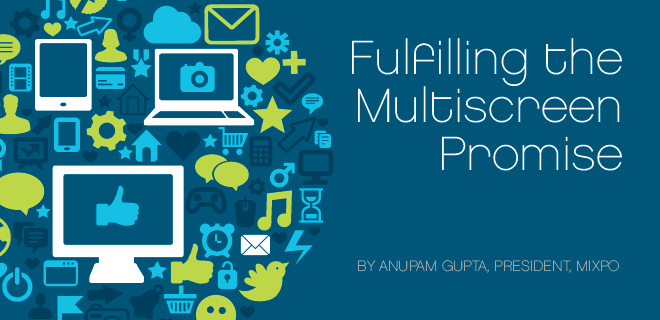
The momentum behind multi-screen media is building. Consumers who interact with at least two screens at a time have now reached a majority, and that is seen by many as a tipping point for digital media strategy to shift accordingly. Advertisers are showing increased interest in executing campaigns across screens.
Now, more than ever, the various moving parts of the marketing engine that drives branding need to work together. Interactive digital video will be the spark for that engine.
The Data Is Strong
September was a watershed month for multi-screen research and campaigns. GfK MRI’s iPanel showed that almost two-thirds of tablet owners watch television while also using their tablets. According to the iPanel data, 63% of tablet owners used their device while watching TV in the last seven days.
The behavior is not limited to just a few shows. 41% of tablet owners’ total TV viewing time is devoted to this form of two-screen viewing. Many two-screen viewers used their tablet to enhance their TV-watching experience. More than 16% watched a video clip related to a show being watched.
More than 28% of two-screen viewers used their tablet to look up more information about a product advertised during a show they were watching and 12% purchased a product advertised during a show.
On that same day, Google released a study that found consumers spend 4.4 hours of leisure time in front of multiple screens daily. Its findings showed consumers spend an average of 17 minutes per interaction on a smartphone screen compared with 30 minutes on a tablet; 39 minutes, on a PC or a laptop; and 43 minutes, on a television.
Google identifies two types of screen use: sequential and simultaneous. The former, more common, typically occurs over the same day. Some 98% of people move between devices in the same day to accomplish a task. That’s not a typo: 98%.
The Opportunity Is There
The payoff in media buying efficiency and increased customer engagement can’t be ignored. The challenges for media buyers, owners and infrastructure providers will be different. Here’s how it breaks down:
Ad Sales: The challenge before media companies and premium publishers today is to seamlessly and cost effectively connect advertisers and viewers across all of their digital devices.
A great example can be seen in Mixpo’s relationship with Univision. Univision has teamed up with Mixpo to successfully offer advertisers integrated advertising packages that reach across its vast array of TV, online, mobile, and tablet properties.
This is the future of multi-screen media. It opens the buying process to one purchase order, one billing statement and one performance analysis. It allows media to be planned and bought in a truly cohesive fashion. And it meets the viewer where they live – on several devices.
Ad Operations: While ad sales presents a beautiful picture of four screens all running the same video ad, anyone in a modern ad operations team will tell you it’s a bit more complicated than that. When you consider the fragmented OS environment for mobile and tablet devices, the growing number of device makers, various ad formats, and legacy platforms and standards, you begin to realize we’re not talking about four screens. We’re talking about thousands of screens that your video ads need to run on.
Ad ops teams around the world are finding that delivering the high-quality ads that advertisers demand across all of their digital properties is a time-consuming and resource-intensive endeavor. All of this puts pressure on ops teams who need to provide a seamless multi-screen environment for advertisers while delivering ads at scale.
Multi-screen ops teams need to be up to speed on the nuances of both the mobile web and in-app environments along with the best ways to integrate ad experiences and ad products. This requires integrating and updating various ad servers to support new formats and ensure all are compliant with the latest standards such as MRAID and VPAID.
Ad Technology: Current technology enables video ads to run on desktops, smartphones, and tablets. However, as we stand at this inflection point of multi-screen video advertising, technology platforms need to step up to remove the overwhelming complexity currently present in the industry and work with media companies and premium publishers to clearly define the value of multi-screen advertising and execution across sales, ops, and ad delivery teams.
To do so, focusing on the following near-term goals will help bring to bear rubber-meets-the-road solutions:
- Optimize by device. The reality is that not every device has the same capabilities and the mobile and tablet markets will only be getting more fragmented in the short-term. Ads need to detect the device they’re running on and display the best possible experience based on the available capabilities.
- Know your audience. Don’t expect a single creative execution to apply to all screens. Viewers consume content across multiple devices and interact with each of those devices uniquely. When delivering campaigns across screens, ads need to be tailored to the device their being viewed on.
- Standardize basic mobile and tablet ad features. Writing custom code every time a device-specific navigation is used is simply not scalable. Success for today’s media companies and premium publishers is measured in hours and minutes, not days and weeks.
- Simplify HTML5 authoring. A full-fledged ecosystem has been built around Flash over the last 15 years that includes tools, designers, developers, and organizational processes. Despite HTML5 being a necessary part of delivering engaging and interactive ads on mobile and tablet properties, a similar ecosystem is not currently in place. Ad delivery teams need to be able to author HTML5 ads with ease and speed.
- Educate sales teams. The video advertising landscape is rapidly evolving. Sales teams need to be able to communicate the value of one ad buy to all properties ad products.
Fulfilling the multi-screen promise is a tall order, but one that must be kept if the media buyers, owners and infrastructure providers are to meet the user at key engagement points. Those engagement points clearly cover several devices. Multi-screen strategies will only become more important as mobility increases.
 |
The Brazilian digital advertising scene is heating up – AdMonsters Brazil will bring digital advertising leaders and ops professionals together to discuss and develop best practices for the budding Brazilian online ad infrastructure. Register today for AdMonsters Brazil, which will be held Nov. 28, 2012, in São Paulo. |